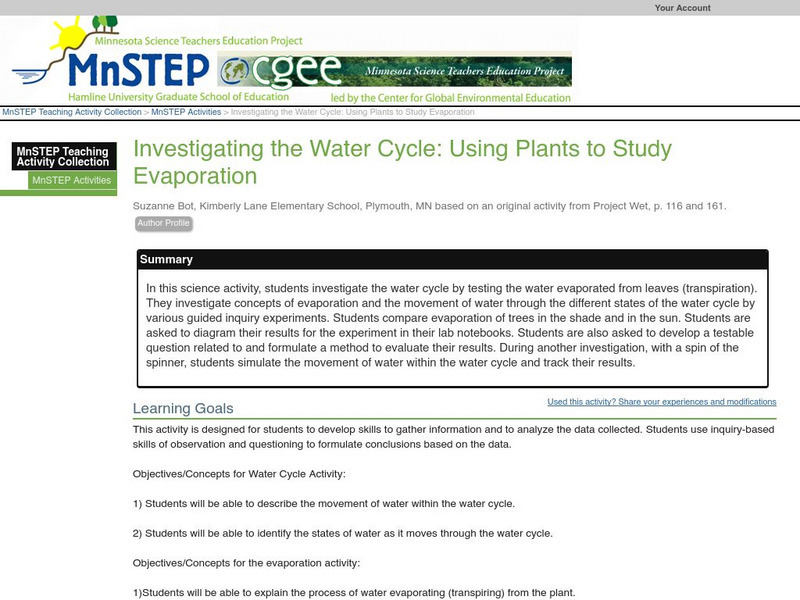Curated OER
Language Arts: How Can Research Shape Ideas?
Students are able to characterize arsenic and determine its potential health threats in writing. They are able to compare and contrast arsenic to other water pollutants using Venn diagrams. Students are able to demonstrate essay skills...
Curated OER
Creature Creation
Second graders listen to a read aloud of a fictional story about a frog. They compare the characteristics of the main character with a real frog. They work with two partners to create a creature; one student draw the head, one the body,...
Curated OER
WorldWatcher Project: Global Warming Project
Young scholars conduct lab activities, computer visualizations, and other various forms of research in preparation for a role-play activity in which they assume the identities of advisors to various heads of state on the subject of...
Curated OER
Obesity
High schoolers examine how hormones affect different tissues. In groups, they make their own hormone-receptor model and identify the characteristics of tissues that respond to the different hormones. To end the lesson, they examine the...
Curated OER
Genes and Aging
Students explore genes and the way we age. They assemble a worm collection device called a Baermann Funnel. Students collect Caenorhabditis elegans or other active nematodes from local soil samples. They observe the appearance and...
Curated OER
Something's Fishy
Learners study fish habits and traits. For this marine life lesson, students complete four learning centers of a fish memory game, a fish habitat study, draw and glue fish craft activity, and a fish read-a-thon. Learners complete their...
Curated OER
Lesson Plan: Global Warming
Students explore the concept of global warming. In this climate change instructional activity, students explore the provided links to PBS NOW sources and research the greenhouse effect and the effects of global warming. Students...
Curated OER
Sustainable Southern Belize: Coral Health Lesson Plan
Fifth graders investigate coral reefs and the dangers they face by labeling and drawing. In this oceanography lesson, 5th graders view a PowerPoint presentation of photographs of coral reefs in Belize. Students investigate...
Curated OER
Science: What Is a Barometer?
Fourth graders discover how barometers help to predict the weather. Using newspapers, they examine the weather forecast and determine the meaning of high and low as they pertain to pressure. After making cluster diagrams, 4th graders...
Curated OER
Food Webs
Students research an animal to define its food web and life cycle. In this animal life cycle lesson, students research an animal and define its food web. Students then present their animal food webs to the class and note other animals in...
Curated OER
Plentiful Plants Book Review
In this literature instructional activity, students choose a nonfiction book about plants to read and report about. They note the title, author, illustrator, and publisher. They follow five directions to draw and label plant diagrams,...
Curated OER
You Are What You Eat!
Students calculate the calories in food samples and plan a meal based on the calorie amount. In this calories lesson plan, students also devise a work out program to burn off the calories.
Curated OER
Emerging Viruses
Students study the characteristics of living things and explore the characteristics of viruses including their structure, function, and reproductive cycles. They also explore the impact of viruses on human health by discussing common...
US Geological Survey
U.s. Geological Survey: What Is the Water Cycle?
A quick summary of the water cycle that includes a diagram of the cycle, with links to in-depth explanations of each component of the cycle. Click "water-cycle home" to access water-cycle resources in a variety of languages.
Science Education Resource Center at Carleton College
Serc: Investigating the Water Cycle: Using Plants to Study Evaporation
In this science activity, students investigate the water cycle by testing the water evaporated from leaves (transpiration). They investigate concepts of evaporation and the movement of water through the different states of the water...
University of Washington
University of Washington: Water Cycle
This page from the University of Washington has an excellent diagram of the water cycle. There are 8 water cycle hands on activities on the bottom of the page. Also there is a link to a teacher reference page.
US Geological Survey
U.s. Geological Survey:the Water Cycle for Kids and Students: Advanced Students
Hyperlinked diagram provides an in-depth explanation of each phase of the Earth's water cycle.
US Geological Survey
Usgs: The Water Cycle
Learn about the movement of water from Earth's surface to the atmosphere with this site. Site describes the water cycle in words and with a diagram. Also explored on the page is the distribution of Earth's global water supply.
Ohio State University
Osu: Beyond Weather and the Water Cycle: The Sun: Earth's Primary Energy Source
Extensive article that discusses the first principle of climate science, i.e., that the Sun is the primary energy source for the climate system of the Earth. Presents five concepts for this principle and explains each, providing...
University of Illinois
University of Illinois Urbana Champaign: A Summary of the Hydrologic Cycle
Animation and text explain the water--or hydrologic--cycle, which is the process that water undergoes in nature.
University of Missouri
University of Missouri: The Nitrogen Cycle
This resource provides an explanation, accompanied by diagrams, of the nitrogen cycle, and also about how it can impact on water quality.
US Environmental Protection Agency
Epa: The Water Cycle [Pdf]
An illustrated diagram of the water cycle that students can use for study.
Indiana University
Indiana University Bloomington: The Rock Cycle With Geologic Settings [Pdf]
A colorful diagram of the rock cycle showing the stages that rocks go through as they are transformed by different processes such as weathering, lithification, and crystallization.
US Geological Survey
U.s. Geological Survey: The Water Cycle: The Oceans
Through pictures, diagrams, and charts, learn how the ocean serves as a storehouse of water.



















![Epa: The Water Cycle [Pdf] Graphic Epa: The Water Cycle [Pdf] Graphic](https://content.lessonplanet.com/knovation/original/42176-ac4345d9392f3783430ed3628fd17cec.jpg?1661261553)